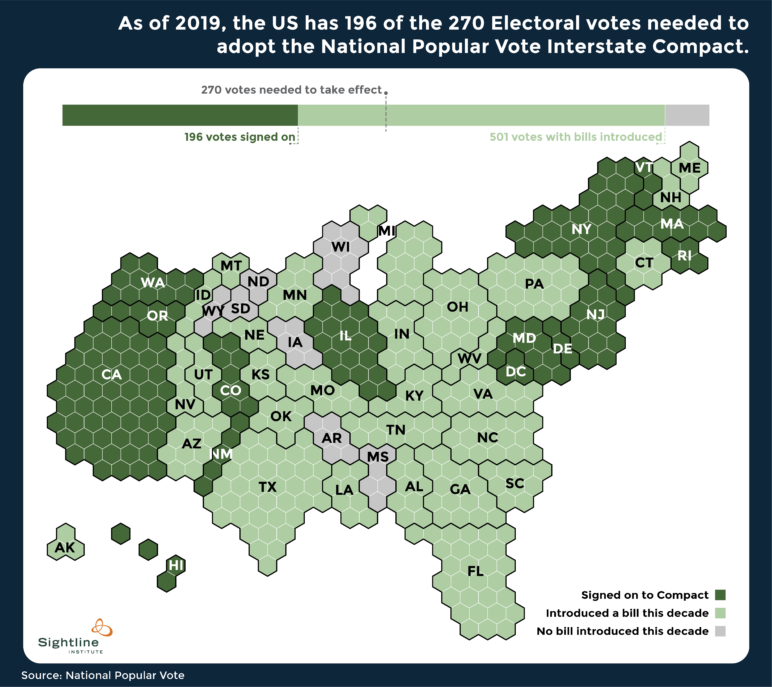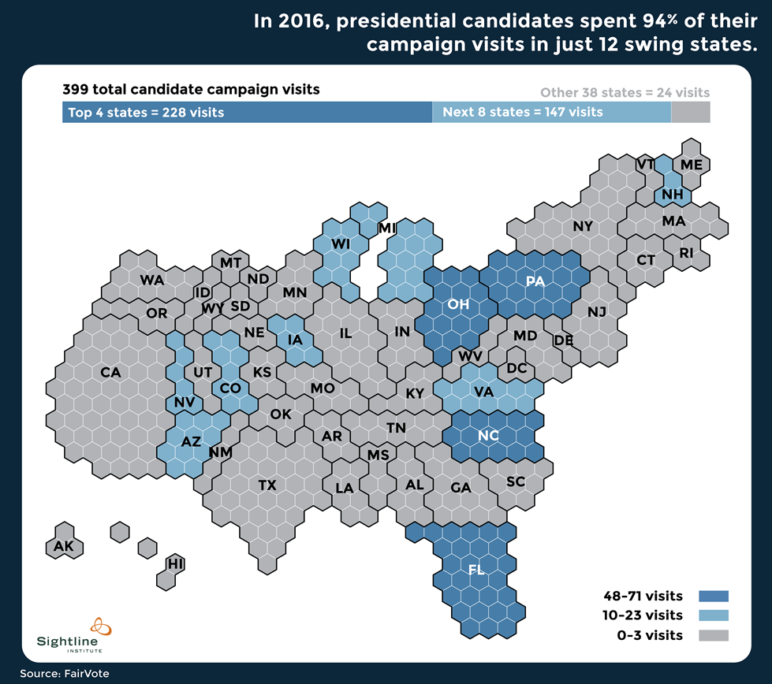On June 5, Oregon’s legislature voted to become the 16th state to join the National Popular Vote Interstate Compact. The initiative is an agreement among states to give their electoral college votes to the winner of the national popular vote. With Oregon’s adoption, the compact now has 196 electoral votes behind it and it needs a total of 270 electoral votes to take effect, meaning the presidential candidate with the popular vote would theoretically also earn the most electoral votes. All but seven states have introduced a bill in recent years to adopt the Compact.
In the map below, each state is sized according to its number of electoral votes. You can see, for example, that Wyoming has just three votes (fewer people live in the entire state than in the city of Portland) while California’s 40 million residents have 55 electoral votes. Dark green states have signed on to the Compact and light green states have introduced a bill within the last decade.
 Don’t we need a constitutional amendment to change the Electoral College?
Don’t we need a constitutional amendment to change the Electoral College?
No.
The Constitution leaves the decision of how to select Electors and how to distribute their votes completely up to states. Most state legislatures have chosen to give all their Electoral College votes to the candidate who wins in their state, but they could instead choose to cast their Electoral College votes for the candidate who wins the national popular vote.
What is the Compact?
The National Popular Vote Interstate Compact is a binding agreement among states. Once enough states sign on and they can determine the election outcome, the Compact will take effect. In the next presidential election, all signatory states will cast their Electoral College votes for the winner of the national popular vote for president. By signing a compact to act together, state legislators can stand together for the principle that the presidential candidate who wins the most votes should win the presidency.
Will the Compact disadvantage small states?
No.
The way that states currently divvy up their electoral college votes advantages swing states, not small states. Candidates spend 94 percent of their campaign stops in 12 states and two-thirds of their campaign stops in just six states. None of the smallest states are in that lucky bunch. The map below shows the states sized according to their electoral college votes and colored according to how many visits they received in the 2016 cycle. Candidates did at least 48 events in each of the four dark blue swing states but flew over most other states. Year after election year, Oregon—and other “safe” states like it—get exactly zero presidential campaign visits. Oregon votes just don’t make a difference to candidates: as long as the Democratic candidate wins more votes than the Republican, she will get seven Electoral votes whether she wins one million or two million Oregon votes, and the Republican candidate will get zero electoral votes whether he wins one million or two million Oregon votes.

And swing states don’t just get candidate visits; they get more money and special treatment after the election is over, too. Swing states receive 7 percent more presidentially controlled grants, twice as many disaster declarations, more Superfund and education requirement exemptions than “safe” (non-swing) states do, and their priorities more influentially shape federal policies on economics and trade.
Who would benefit from the Compact?
A national popular vote would make every vote matter, so everyone who chooses to vote would benefit.
States that honor their citizens’ right to vote (as Oregon does) would get more votes counting in the presidential race. With 90 percent of eligible citizens registered to vote, and record high voter turnout, Oregon would make the most of its voting population. But states that try to prevent their citizens from voting would get fewer votes than they could by following Oregon’s lead. (By the way, honoring the right to vote is a bargain compared to suppressing voters.)
Interestingly, Colorado, a swing state that arguably benefits from the current Electoral College set-up, signed on to the Compact this year. Bravo to Coloradans for caring more about a fair and functioning democracy than about getting special treatment as a swing state.
What are the Compact’s chances of taking effect?
Astute readers will notice that most of the states that have signed on so far are “safe blue” states. The exceptions are purple New Mexico and Colorado. The closer the Compact gets to taking effect, the harder it will be to get states to sign on. But the more states that sign on, the more attention the Compact receives, moving the country towards the idea that the presidential candidate with the most votes should win.
What’s next?
Advocates for the Compact will continue to work in the 27 states that have introduced bills to get some of those bills passed and more states signed on to the Compact.
Kristin Eberhard is a senior researcher at Sightline. She researches, writes about, and speaks about climate change policy and democracy reform. Find her latest research here. If you have questions or would like to make a media inquiry, contact Sightline’s Communications Manager Anne Christnovich.


Comments are closed.